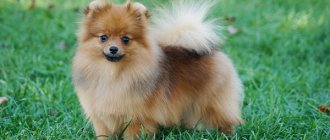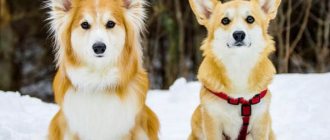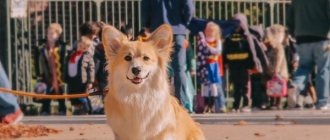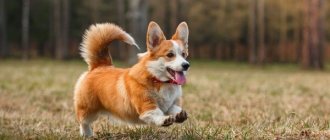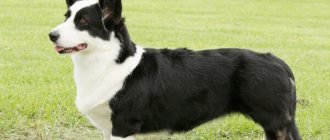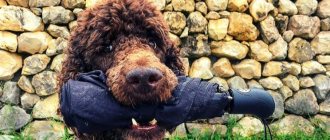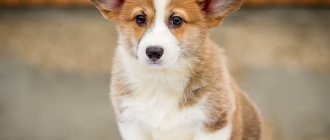Corgi with or without a tail: is a burning topic that has been actively discussed in Russia and abroad for many years.
This topic is actively discussed among people who have little contact with this breed.
Many citizens, seeing a corgi with a tail, wonder why some have a long tail, others have a medium tail, and others have a short one.
This article will answer this interesting question. She will also explain why corgis are sometimes found without a tail.
How to care for the hair on a Corgi's tail? There are a lot of tools for this, one of which can be purchased here. Professional pet trimmer Baorun Pro.
New users can receive a discount coupon.
Truths and myths about the bobtail gene (Does the gene really cause health problems?)
For a long time, there were fierce discussions around the topic of the bobtail gene. Many have argued that the Corgi's genetic predisposition to a short tail is dangerous, harmful to the pet's health, and often even fatal.
However, the Norwegian Veterinary Institute has taken up this issue. In the process of studying this problem, an X-ray study was carried out to identify pathologies of the spine of individuals with the bobtail gene. Both live and stillborn puppies were studied.
As a result of an X-ray study and many years of observation of Pembrokes, it turned out that the bobtail gene does not in any way affect the pathology of the spine of these dogs. “Kutsyki” live as long as a corgi with a tail.
Who are Corgi Bobtails?
When the first bobtail standard was first adopted, it was decided to see the Pembroke Welsh Corgi as a natural breed. And this is not surprising, since most Pembrokes in earlier times were born bobtailed.
From the photographs of the distant ancestors of this breed, it is clear that the length of the tails of dogs varied within different limits - from the length of the tail of the terrier to the length of the short undocked tail of the bobtail.
Over time, this trait was lost as breeders noticed that a docked tail looked much more attractive than a half- or third-length stub. Therefore, less attention has been paid to bobtail breeding.
After docking was banned in the 80s, breeders in nurseries began to solve the problem of how to return a natural short tail to a corgi.
There have been many rumors about the bobtail gene. Some producers claimed that because of it, the ability of the hock joints deteriorates, the gene causes disorders in the spine, promotes curling of the tail and the birth of offspring without an anus. But worst of all, high fatal risks (morbidity and early death) were predicted.
Russian breeders together with the Norwegian Veterinary Institute were able to refute the frightening predictions. Research and many years of statistics have proven that dogs with short tails have the same high survival rate as long-tailed Pembrokes.
Today, Corgi Bobtail tail lengths range from none at all to half the length. Most often, a puppy has 1-2 vertebrae in its tail stump. In young animals it looks rather ugly, but with age it fits perfectly into the back “pants”.
The lower part of the stump has a light wool covering with a pile length shorter than that on the “pants”. This factor visually makes the tail longer. In an effort to give the growth a shortened appearance, specialists trim the top layer of fur with serrated scissors.
Research and many years of statistics have proven that dogs with short tails have the same high survival rate as long-tailed Pembrokes. Links to the study: https://academic.oup.com/jhered/article/100/2/236/851021 https://link.springer.com/article/10.1007/s003350010253
Prohibition on docking. What do the experts say?
Many years ago, imagining a Pembroke with a tail was considered “a complete disgrace.” However, over the years, following the passage of the docking ban, a new generation of breeders can no longer see the appeal of a “heart butt” without a tail. But breeders cannot always guarantee that the position of the appendage in an adult dog will meet the requirements of the standard.
Therefore, breeders immediately warn that the dog owner should be aware that the four-legged tail may disappoint in the future. After all, immediately after birth, puppies have thick and straight tails. But already over the course of 1.5-6 months, the tail can be wrapped in a ring or thrown towards the back.
In this case, dog breeding experts advise not to be disappointed in the breed. Today, judges at Russian exhibitions do not focus on incorrect tails, since after the change in European standards, Russian breeders have not yet had time to select for the caudal process. However, a way out has been found - surgical intervention.
Pembrokes with irregular tails kept for exhibitions have their tail ligaments trimmed by their owners.
This is how a curled tail is corrected. In Russia, such dogs have already appeared, however, when mating the offspring of such animals, corgi puppies with a tail always receive the wrong parental tail.
Puppy training by month
| Age | Upbringing |
| 2 months | The first couple of weeks the puppy is in quarantine and rests from the first vaccinations. Walking is prohibited for a puppy, so it’s time to set the boundaries of what is permitted:
|
| Age | Socialization |
| 3 months | The beginning of the formation of the nervous system and laying the foundation for the norms of behavior and the dog’s relationship with other people and animals. Adding to the list of rules:
|
| Age | Training |
| 4-5 months | The puppy begins to gradually get used to it and notice interesting things for itself, while at the same time testing the owner’s patience to the limit. Therefore, in order to pacify the rebellious spirit of the young dog, the time has come to move on to training. At this stage, the owner is required to be patient and assertive. The puppy is taught:
|
| 6 months | With this age, defects in previous stages become noticeable. Moreover, corgis enter puberty and begin to explore the boundaries of the possible with particular passion. Often just to make the owner emotional. |
Reproduction and lifespan
The cheerful shepherd dog lives from 13 to 15 years. He faithfully serves the owner, fulfilling all his commands. The breeder must know the classification of the Welsh Corgi breed and be able to distinguish a Pembroke from a Cardigan. A female dog's first heat occurs at approximately 6 months.
But she is not yet suitable for reproduction, as she is too young. Males reach the age of puberty even earlier, at 4-5 months. At this age they can already conceive offspring. However, experts recommend breeding individuals older than 2.5 years, as they are well suited for reproduction.
It is interesting that Welsh puppies from birth have a color that can change as they grow. For example, if a baby was born reddish, by the age of 1 year he may become black and white.
What do boys and girls look like and how do they differ?
It is not difficult to distinguish a corgi girl from a boy; females look smaller than males..
Girls of the Prembroke species weigh 9-11 kg, and Cardigan - 11-15 kg, while boys of both species weigh 2 kg more.
They are also distinguished by character traits: girls are calmer and more obedient than boys, and they are also more affectionate . Males, on the other hand, are distinguished by their mobility and activity.
To dock the tail or not
Whether or not to dock a corgi's tail is up to each breeder to decide for himself. This procedure can be carried out in the first 3 days of the puppy’s life, so you need to quickly decide whether to dock your pet or not.
You can focus on your preferences or on what exhibitions Pembroke will participate in in the future. In some countries around the world, docked participants are not allowed to participate in exhibitions, even if they live in a state where this procedure is permitted.
If you are purchasing a pet for a family, you should look at photographs of puppies and adult corgis and make a choice in favor of the one you like best. Pembrokes look great with or without a long tail.
Experts on the ban on docking
Just a few years ago, Pembroke Welsh Corgi dogs with tails could not look natural. Today the situation has changed, and such individuals can even participate in competitions and exhibitions. However, many experts say it is impossible to accurately predict what an adult dog's tail will look like.
Since the docking procedure is carried out in the first days of a puppy’s life, the shape of the tail may change as the pet ages. The tail can be thrown up or curled into a ring.
Experts urge not to despair if the shape of the Pembroke’s tail suddenly changes, since at domestic competitions judges have not yet focused on the irregular shape of the tail. In any case, you can resort to surgical intervention, as a result of which the irregularly shaped process is corrected.
It doesn’t matter whether the corgi has a docked tail, a short one or a long one - the main thing is that the pet is loved, lives in a warm, friendly atmosphere, and enough attention is paid to the care and education of the corgi. After all, if a pet is happy, its owner will be happy too.
The following breeds are considered small dogs without a tail:
- French Bulldog. The ancestors of the breed were fighting bulldogs, which took part in fights in the rings, but now this short-tailed breed has completely lost its aggressive qualities.
The basis of the modern popularity of the breed is its small height of up to 35 cm, docile nature and love of life. Bulldogs respond well to training, and they simply need daily active walks. Curious and cheerful, they make loyal companions for families and single people alike.
Welsh Corgi. The breed is the result of selection, and the most devoted fans of the breed are members of the English royal family. A peculiarity of the breed is that puppies are sometimes born without tails at all. The calling card of the breed are their ears and furry pants. Even the cartoon image of the breed is very recognizable.
IMPORTANT: when choosing a dog breed without a tail, remember that there is a risk of getting a litter with a gene mutation, so in the case of Rottweilers and Dobermans it is better to look for a partner with a docked tail, and with other breeds it is better to look at the pedigree before mating in order to reduce the risks of getting offspring with recessive T -genome.
Interestingly, gene mutations also occur in mongrel dogs, so even in a shelter you can meet puppies with a miniature tail from birth.
Is it necessary to dock the tail?
Today, the attitude towards docking the tail of the Pembroke Welsh Corgi is controversial. In fact, this breed looks great with or without a tail. Therefore, you need to focus primarily on participating in exhibitions abroad, where an animal with a docked tail process will not be allowed to be shown. For the animal itself, the presence or absence of a tail does not play any role.
Breeders, as a rule, prefer to dock the tail so that the owners like the dog.
In situations where a corgi is purchased for a family, discussing the appropriateness of docking is pointless. To do this, you should look at puppies and adult animals in order to decide whether you want to see the dog's fluffy pants or a curled tail on the back.
Types of pets by parameters
Based on the presence of various parameters, there are several types of Welsh Corgis. Let's look at the main ones.
No tail
There are Prembroke Welsh Corgis with a very short tail or almost no tail.
There are two reasons for this:
- the dog had his tail docked;
- congenital absence of a tail (bob tail).
Congenital absence of a tail is caused by the presence of the bobtail gene in the dog's parents.
With a tail
The Cardigan Welsh Corgi always has a long tail, they have never had their tails docked, nor have they been bred to bobtails.
Since in many countries societies for the protection of wildlife have achieved a ban on tail docking, you can also find prembrokes with tails of different lengths depending on the genes of their parents.
Longhair
Cardigan and Prembroke Welsh Corgi puppies may be born “shaggy”, i.e. with long and fluffy hair influenced by the shaggy gene, which is called fluffy.
This is where the subspecies of corgi came from - fluffy . Experts classify such individuals as defective, and they do not take part in exhibitions. However, this fact does not prevent many owners of such pets from loving and admiring their animals.
According to owners, long-haired corgis have a very good character and excellent health..
Shorthair
Prembrokes have a medium-length coat, thick and silky; short-haired individuals are more common among Cardigan Welsh Corgis, which have a dense two-layer coat and a dense short undercoat.
As a rule, short-haired dogs of this breed do not require special care for their coat; it is enough to brush it 1-2 times a week; you should not bathe your pet often.
With blue eyes
This unusual and attractive eye color is found among cardigans. The shade can vary from blue tones to light blue.
Most often, blue eye color is characteristic of individuals of blue merle or merle colors..
The species is considered endangered in its homeland due to the greater distribution of its fellow species, the Prembroke.
Modern tailing standards
Modern corgi tail standards vary. The main difference is at what level the Pembroke's undocked tail should be set.
European
The English Kennel Club stipulates that the Pembroke's tail should be positioned in line with the back. In an excited state and in motion, its normal position is slightly above the topline.
Russian
The Russian Cynological Federation introduces its standards for Pembroke tails:
- Preferably a natural short shoot.
- If docked, then as short as possible.
- If not docked, then placed in line with the topline in motion, slightly raised. When at rest, it should be slightly lower than the topline.
OKD
This is a special training program developed in the 1920s and slightly adjusted by modern dog handlers. It is necessary for comfortable coexistence with the dog and is aimed at teaching commands and developing an adequate attitude to various stimuli.
Classes on OKD (general training course) are conducted under the guidance of an instructor and take place in the form of group or individual lessons.
Do Corgis need to have their tails docked?
There is no clear opinion about docking the tails of Welsh Corgis. Dogs of this breed look good and feel great with or without tails. If “Korzhik” participates in exhibitions, remember that in selected countries there is a ban on docking the ears and tails of dogs. For the Welsh Corgi breed, there is no fundamental difference in the presence or absence of a tail. Breeders dock the tails of dogs of this breed at their own discretion. Docking is done to please potential buyers of cute dogs.
If a dog was purchased to live at home, with a family, discussion is pointless. Just look at the puppies and decide whether you want a tail with a ring on the back or whether you would like the dog’s tailless, fluffy butt.
How to choose a Welsh Corgi?
You should approach the choice of a Welsh Corgi puppy wisely and thoroughly, after visiting several nurseries and familiarizing yourself with the conditions of their maintenance.
When choosing a Welsh Corgi, you should adhere to the following rules::
- contact the services of a reputable breeder who knows a lot about the breed;
- pay attention to the puppy’s parents, their health, especially the mother;
- feel free to ask for a passport and veterinarian. pet card;
- do not run after a low price, this should alert you;
- pay attention to the external characteristics and behavior of the puppy, he should not be lethargic, but under no circumstances should there be aggression.
The “royal” Welsh Corgi breed will be an ideal companion for you and a friend and protector for your children . The pet will get along well even in a small apartment and small house.
And a wonderful sense of humor and good-natured character will not let you get bored.
What are the tail requirements for real corgis?
Unlike European countries, in Russia the Cynological Federation, which is a member of the FCI, has established its own tail standards for real corgis.
The requirements are briefly stated there:
- Preference is given to a natural short ponytail.
- If docking was performed, the tail should be short.
- If docking has not been performed, the caudal process should be in line with the back during movement or should be slightly elevated. In a calm state, it should be lowered below the line of the back.
A high and too low position is undesirable. And it is observed with sloping croup. Here it should be understood that only with a sloping croup will the tail be set low.
This body constitution is typical for the Cardigan Welsh Corgi, but this is not allowed for the Pembroke.
History of the origin of the breed
Legend
There is a beautiful legend about the origin of both types of corgi.
A long time ago, elves lived in what is now Great Britain. Small and fragile, they died from human touch, and people caught elves for fun and tore off their wings. Then the fairy-tale inhabitants abandoned their wings, choosing a horseback mode of transportation. They replaced horses with small, obedient dogs. If you look at the back of the current representatives of the Corgi breed, you can see a strange pattern that resembles a saddle imprint. The animals wear it in memory of the time they served as sled dogs for the elves.
The human population grew, displacing the elven one. It so happened that one cruel boy caught the elf prince, but two other children fought him off and set him free. The mother, the queen, rewarded the peasant children who showed mercy by giving them two corgi puppies. The children brought living gifts home and raised them as little guards and shepherds.
Reality
According to more down-to-earth hypotheses about the origin of the Corgi dog breeds, everything was different. The most common version is that the Cardigan Welsh Corgi and the Pembroke are completely different breeds. The first was brought by the Celts to Great Britain in 1200 BC. Pembroke came to Wales with Flemish weavers in 1107.
The second hypothesis talks about evil Egyptian dogs. They were brought to Britain in the 10th century by settlers. Dogs performed several functions at once - herding, guarding and hunting.
Another theory, hardly inferior in romanticism to the legend of the elves, tells of dwarf tribes. They lived in Britain, were distinguished by their developed intelligence and extremely short stature. Time passed, the dwarf race lost to the white-skinned, tall people neighboring them and fighting for territory. Soon the dwarfs died out, leaving behind them mounds, stone circles and small, very smart dogs. They became the ancestors of modern Welsh Corgis of both types.
The origin of the name of the breed is interesting. According to the first version, “corgi” is translated from the Celtic language as “evil dog.” The second option will tell the reader about the Welsh corgi, whose name translates as “dwarf dog” or “dog of dwarfs.”
Appearance
In the international register of FCI (Federation Cynologique Internationale), the Pembroke standard is numbered 39, and the Cardigan standard is numbered 38. In the photo, Corgis look quite strong, squat dogs with well-developed muscles. When judging, the balance of the frame is very important; it should not be too heavy or light. Upon examination, the quadruped should demonstrate strength, endurance and self-confidence. The look is lively, interested, but at the same time controlling, like all shepherd dogs. Malice or timidity are recognized as disqualifying vices.
Height ranges from 25 to 30 cm, regardless of gender, the weight of dogs is stipulated by the standard:
- Males: recommended 12.3 kg; maximum 13.6 kg.
- Females: recommended 11.4 kg; maximum 12.7 kg.
Breed standard
- The head is wedge-shaped, and its overall silhouette resembles that of a fox. The shape of the head should not give the muzzle the appearance of a wild animal, all features are balanced and smooth. The skull is almost flat and wide. The tips of the ears and the nose form a regular, inverted triangle. The transition to the bridge of the nose is moderate, the bridge of the nose itself is smooth and parallel to the line of the forehead. The under-eye area and cheeks are moderately filled and should not appear flat or convex. The cranial part, from the occipital protuberance to the transition to the bridge of the nose, is longer than the muzzle, proportion 5:3.
- Teeth are complete and in correct bite.
- The nose is square when viewed from the front, rectangular from above. Pigmentation is only black. The nostrils are medium-sized, oval, elongated vertically.
- The eyes are of medium size, set fairly close, at a medium height. The incision is oval, the inner corner of the eyes is slanted towards the nose. The eyelids are dense, fully pigmented in the darkest possible color, preferably black. Eye color should be in harmony with the main color, but a dark brown palette is preferable.
- The ears are large, triangular, with rounded ends. The dog has well-developed, acute hearing, which is noticeable by the mobility of the ears.
- The body is elongated and squat. The neck is quite strong and long. The sternum has an oval shape in cross-section, descending to the elbows, but not elongated in length. The strong, muscular back, when viewed from above, tapers from the shoulder girdle to the tail. A chest that is too deep or wide is considered a defect. The line of the back is straight or slightly lowered at the transition from the withers to the neck. The visual effect is created by the special, heavy structure of the wool. The withers are well defined, set clearly above the elbows.
- The limbs are strong and quite thick. Forelegs with elbow joints laid back. When viewed from the front, the front legs, when moving, are slightly inclined towards each other. This is a natural compensation to distribute the load with short stature and a wide sternum. The length of the carpal bone is less than the length from the metacarpus to the shoulder joint. The hind legs are level when viewed from the front. The thigh is quite long, with well-developed muscles. The joints are strong and at natural angles.
- Tail – natural or docked. Despite the rule on mandatory tail docking, adopted in 1934, modern canine organizations have a sharply negative attitude towards interference with the natural appearance of dogs. In its natural form, the tail is strong, rather long, carried at a medium level or continues the line of the spine, curved like a saber.
Breed standard and what purebred dogs look like in the photo
Dogs of this breed are often compared to foxes due to the elongated and pointed structure of the muzzle, and the jaws are designed in such a way that it seems as if the dog is constantly smiling.
Welsh Corgis have a stocky build with a somewhat elongated body and short legs, but this does not prevent them from being energetic and quite fast.
Here are the general characteristics of the breed:
- The dog's weight is small, from 11.5 to 13 kg;
- height varies from 25 to 30 cm at the withers;
- There are several types of color, the most common colors are fawn and red with white spots, and there are also sable, tricolor, black and tan;
- the average life expectancy of the breed is up to 13 years;
- the character is sociable and friendly, dogs of this breed are loyal pets to the owner, and at the same time they treat all family members with love, without constant attention and communication they begin to feel sad;
- Welsh Corgis are considered dogs with high intelligence and great potential in training and learning.
Corgis are only suitable for living in a house or apartment..
An aviary is not the best place for them. Life on the street has a depressing effect on a dog of this breed, increasing feelings of loneliness and melancholy.
Purebred representatives of the Welsh Corgi breed have the following external features:
- elongated muzzle, long skull;
- eyes are round, slightly protruding;
- ears are small and pointed;
- medium length neck and voluminous chest;
- the tail is short, docked, but recently there have been representatives with tails of different lengths;
- The coat is short, thick and harsh.
Among the representatives of the breed there are also long-haired individuals; such dogs are called “fluffy”.
Corgi and children
Corgis are active and cheerful dogs. Tireless nannies will be happy to run with the children. It is necessary to take into account the peculiarity of this breed of herding dogs - they are capable of biting the legs of children when playing with them, but they can unwittingly scare them. The child will think that the cute dog, recently playful, suddenly decided to pounce and bite. Due to their breed characteristics, the “korzhiki” bite the legs: initially the dogs were shepherds, in a similar way they gathered the herd into a heap, giving direction to those who strayed from the herd. Explain to children that there is no need to be afraid.
If your child is afraid of dogs, consider choosing a puppy of a different breed. Corgis are genetically programmed to work; this is not an acquired character trait, which means that the dog cannot be weaned from biting its legs.
If children are not afraid of dogs, feel free to take a Welsh Corgi into your home.
Pros and cons of the breed. Suitable for:
An absolutely charming breed is not without both advantages and disadvantages.
Advantages and disadvantages
Good nature. For the most part, charming dogs are good-natured and peaceful towards their owners, family members and other pets. They can behave warily with strangers, but without aggression.
Devotion. This is a one-owner dog; the pet is sociable and affectionate with the rest of the household. But adoration only goes to one person.
Smartness. Very smart animals that are a pleasure to deal with in training.
Well adaptable. When changing place of residence or traveling, “cardi” do not cause trouble for owners, for the most part.
The need for active long walks and regular training. To lazy owners, this will seem more like a minus than a plus.
Excessive manifestation of the herding instinct, they can bite the legs of family members, especially children.
Loud barking. Although most Cardigans are not prone to yelling for no reason, they do have a very deep voice. It feels like it’s not a dog weighing 15 kg maximum that is barking, but a natural German Shepherd.
High cost, everything is clear here without explanation.
Cardigans are suitable for people with an active lifestyle and a responsible approach to keeping and raising a small shepherd dog.
Differences from Pembroke
For a long time, these breeds competed with each other at exhibitions, but today they are often confused. Meanwhile, their differences (as well as similarities) are clearly expressed:
- Story. They were brought not by the Celts, but by Flemish weavers.
- Size. Cardigans are larger and wider in the bones, their body and head are larger. The weight of Pembrokes does not exceed 14 kg.
Ears. Cardigans have much more rounded tips.
Color. Unlike Cardigans, who have many coat color options, Pembrokes have a strictly regulated coat color: red, sable or black.
Tail. Among the Pembrokes, it was previously stopped without fail. Today, not everyone adheres to this tradition, but bobtail is still common. But cardigans have a tail that is always long, fluffy and very beautiful. Before docking was abolished, it was easiest to distinguish them “by the loin part.”
Character. Pembrokes are considered more friendly and sociable. Cardigans are also affectionate with their owners, but behave reservedly around strangers. Loneliness is easier to bear. Because of their different ancestors, Cardigans and Pembrokes have different genetic conditions and disease susceptibilities. For cardigans, this list is a little smaller.
The breeds are similar, first of all, in size, affection, and charming appearance, reminiscent of both a dog and a fox. Both Cardigans and Pembrokes are highly trainable, love new tricks and pick them up literally on the fly. Both varieties are suitable for inexperienced dog owners.
Basic colors (examples with photographs)
Prembrokes and Cardigans differ somewhat in the spectrum of colors, however, there are general rules of the standard for both types: only a black nose, dark eye color and strictly regulated limits of white color distribution.
Tricolor
This type of color implies the presence of three coat colors, one of which will be the main one. It turns out that two more colors are added to the white markings.
One of the subtypes is the black-headed color, such individuals are almost black in color with brown and white markings.
Another common subtype of tricolor is a deep color, when the main color is bright red, black along the body, and white in the areas of the chest, neck and muzzle.
Ginger
The most popular shade for representatives of the breed . At the same time, the red color can vary from pale red to bright shades in addition to a black “mask” on the muzzle, which gives a special charm to the doggies.
Sable
The sable color of the corgi looks truly rich, it gives the impression that the dog is glowing . The essence of the sable color is that the hair at the base is one color, and at the tips another.
Deer
Deer color refers to coat colors ranging from all shades of sandy-golden to very light tones . The highlight of this color will be the smooth transition from dark to light tones on the hips, under the tail, on the limbs and on the dog’s belly.
Grey
Gray Welsh Corgis are sometimes called Black Corgis. At birth, puppies are gray in color, but then it gradually fades and the dog’s back is covered with a dark gray or black-and-white color.
White
A completely white color is not inherent in the Welsh Corgi . The merle or blue merle color is considered a very beautiful phenomenon. With this color, the main coat of the Corgi is white-gray, white or gray with blue tones.
The secondary color range is represented by dark marks or spots.
brindle
Another type of Welsh Corgi color is brindle . It is represented by the presence of transverse stripes on the dog's body. The stripes are darker than the main color, often dark brown tones.
Character
All Pembroke owners claim that these small shepherd dogs have a wonderful character. The main character traits of Pembrokes are energy, developed intelligence, sociability and exceptional friendliness towards people. Pembrokes may growl or bark at other dogs, but will never allow themselves to do this towards people.
Initially these were herding dogs. In order to herd livestock, the animal had to be strong, intelligent and able to work as a team. Many are amazed by the active Pembrokes, who run around a lot, frolic, and love to tinker and fool around. Their appearance, short legs and small size, does not encourage this. Pembrokes have an enviable ability to enjoy life. They are unfamiliar with blues and gloomy mood. Dogs enjoy communicating with their owner, walking and even working. Their eyes are full of guile and joy. It is impossible to remain indifferent at the sight of these dogs.
A second creature as sociable as a corgi is hard to find. This animal not only adores its owner, it strives to be close to him all the time. No matter what you do, your dog will always be with you. These wonderful dogs have one amazing trait: they love to touch their owner with their paw or nose. Pembroke sits next to the owner and gently touches him with his paw several times with short breaks. It seems that he is hinting that there is no better activity than communicating with such a charming and smart animal. If you do not respond to these signs of attention, your pet will realize that he should wait. In order not to miss the moment, when you are free, the animal will lie down at your feet and will be bored alone.
Pembrokes love children. They stoically withstand all the pranks and pestering of the kids. No matter how many Pembrokes are bothered, squeezed, hugged and kissed by children, the beast will never attack children.
Pets believe that they should know about everything that is happening. The pet chooses a place to sleep in the center of the room or in the passage, so that if necessary it can be nearby.
Shepherd work developed in the Pembroke such a quality as fearlessness. Ancestors fought with predators, and a modern Pembroke will not be afraid to fight an enemy much larger than it.
These animals are very sociable. They may use more than just barking and whining to express their feelings. These pets are good singers. If the pet is overwhelmed with positive emotions, then the Welsh Corgi emits various roulades for a long time. If nature has not endowed the Pembroke with a voice, then it grunts, grunts, squeals and mutters. All this sounds so expressive that the owner has no choice but to start a conversation with the pet.
The Pembroke's voice is almost no different from the voice of a large dog. Pets bark loudly and low, which is completely inconsistent with their size.
Pembroke strives to control everyone around him. He wants to organize them and force them to move in one direction. This is why young Pembrokes often bite people's legs. Due to the lack of geese and ducks, Pembrokes take under their protection members of the owner's family, and they have to endure such manifestations of character. You can wean your animal off this habit, but to do this you will have to be patient and persistent.
Pembrokes love to eat. This is also due to genetics. It took a lot of strength to herd cattle, and to become strong you needed to eat a lot. Modern Pembrokes have much fewer responsibilities, but they love to eat, just like their ancestors. A Corgi will never be able to refuse a tasty treat, but overeating can negatively damage the health of a Pembroke, primarily affecting the spine.
Each Welsh Corgi also has individual character traits. Some pets are calm, others are playful, and others like to play pranks. However, no matter what kind of Pembroke you get, rest assured that he will be brave, smart and loyal to you!
Care and maintenance
Representatives of the breed do not require any special care. The only thing you need to do constantly is comb your pet. Typically, brushing is done once every three days, and during shedding - daily.
Daily care required from the owner is examination of the ears, eyes and mouth. If any deviations from the norm appear, you should contact your veterinarian for advice.
Some “korzhists” always check their pet’s stool. It should be well formed, of normal consistency, not too hard or liquid. If the stool changes or appears in a different color (black, green, blood clots), the owner should immediately contact a veterinarian.
As for the content of the cardi, this includes:
- A pet bed or a small cage (box).
- Bowls for food and water.
- Leash and collar.
- Toys.
- Nail clippers.
- Ear swabs and cotton pads (just in case).
- Veterinary first aid kit.
Some people buy costumes for their pets for the cold season. You shouldn’t do this, after all, “cardies” are shepherd dogs with good hair.
Also, the dog needs good, active walks and mandatory “brain food” in the form of training.
Who are Corgi Bobtails?
When the first bobtail standard was first adopted, it was decided to see the Pembroke Welsh Corgi as a natural breed. And this is not surprising, since most Pembrokes in earlier times were born bobtailed.
From the photographs of the distant ancestors of this breed, it is clear that the length of the tails of dogs varied within different limits - from the length of the tail of the terrier to the length of the short undocked tail of the bobtail.
Over time, this trait was lost as breeders noticed that a docked tail looked much more attractive than a half- or third-length stub. Therefore, less attention has been paid to bobtail breeding.
After docking was banned in the 80s, breeders in nurseries began to solve the problem of how to return a natural short tail to a corgi.
There have been many rumors about the bobtail gene. Some producers claimed that because of it, the ability of the hock joints deteriorates, the gene causes disorders in the spine, promotes curling of the tail and the birth of offspring without an anus. But worst of all, high fatal risks (morbidity and early death) were predicted.
Russian breeders together with the Norwegian Veterinary Institute were able to refute the frightening predictions. Research and many years of statistics have proven that dogs with short tails have the same high survival rate as long-tailed Pembrokes.
Today, Corgi Bobtail tail lengths range from none at all to half the length. Most often, a puppy has 1-2 vertebrae in its tail stump. In young animals it looks rather ugly, but with age it fits perfectly into the back “pants”.
The lower part of the stump has a light wool covering with a pile length shorter than that on the “pants”. This factor visually makes the tail longer. In an effort to give the growth a shortened appearance, specialists trim the top layer of fur with serrated scissors.
Research and many years of statistics have proven that dogs with short tails have the same high survival rate as long-tailed Pembrokes. Links to the study: https://academic.oup.com/jhered/article/100/2/236/851021 https://link.springer.com/article/10.1007/s003350010253
What you need to know about bobtail
Some of the theorists of the Pembroke Welsh Corgi breed claim that at the beginning of the 20th century, most of the population of this breed was congenitally bob-tailed. It is, in my opinion, impossible to confirm or refute this statement. Indeed, in those years, statistics on tails were not kept at all. But Welsh farmers may well have noticed that bob-tailed puppies are born from a bob-tailed father or mother and used this knowledge in the process of crossing Pembrokes.
In the 1920s, the Kennel Club published the first Pembroke standard, which stated that this breed has a short tail. Until the 90s, in almost all countries the tails of Pembrokes were docked, and this led to the fact that in the main show lines of Pembrokes the short tail gene was lost, since puppies were selected mainly for exterior qualities. Breeders kept the best puppies for themselves, regardless of whether they had a short tail or not.
In the early 90s, only a few nurseries in England had congenitally bob-tailed Pembrokes. They were Sarah Taylor (Bymil), Peggy Gamble (Blands) and Patsy Hewan (Stormerbanks). In addition, congenitally bob-tailed Pembrokes were found in Jofren and Kaytop kennels, and individual bob-tailed dogs were found in private breeders.
The need for Pembrokes with congenitally short tails arose when European countries began to ban cosmetic surgery on animals. The number of such countries is growing, and these bans now exist in the homeland of the breed in England. The short tail has long been the hallmark of the Pembroke, and the prohibition of docking has forced many breeders to pay attention to congenitally bob-tailed dogs. For example, one of the leading nurseries in England, Belroyd, purchased a congenitally bob-tailed male Siggen's Doffen from the Siggen nursery in Norway for breeding purposes.
As an example of successful breeding of Pembrokes with congenitally short tails on the scale of an entire country, one can take as an example a country such as Norway. There, docking has been prohibited since 1993, and most breeders in this country have agreed to breed congenitally bob-tailed Pembrokes. 17 years after this decision, the statistics of this country are amazing: 66% of the Pembroke Welsh Corgi population there are born with congenital bobtails. At the same time, Norwegian dogs successfully compete with dogs from other countries, and the innately bobtailed Siggen's Uptown Girl won the title of World Champion.
Norwegian breeders achieved such success in the following way. Several breeders with congenitally short tails were imported from England in the early 90s. These sires were inferior in quality to many Norwegian dogs, but they had the short tail gene. Matings with such sires were a step back in terms of the dog’s exterior; they were guaranteed to introduce the short tail gene into the Norwegian Corgi population. Breeders in Norway have agreed that they will use sires with the short tail gene, even if their quality is inferior to other sires available to them in other countries. For many years the Norwegian Corgi Club bred mainly long-tailed and short-tailed dogs in order not to lose the short-tail gene and to improve the quality of the stock with the available long-tailed dogs. And such a wise policy brought results. Norwegian dogs are quite competitive at shows of any rank.
A person completely unrelated to the breed made a major contribution to research into the Pembroke bobtail gene. This is an English geneticist and boxer breeder, owner of the Steynmere kennel, founded in 1949 by Dr. Bruce Cattanach. In 1992, he began an experiment to transfer the gene for a short tail from one breed, the Pembroke Welsh Corgi, to another, the Boxer. This study, which involved the Human Genome Institute in England, the Norwegian Veterinary Institute, Norwegian Kennel Club geneticist Olave Hedne, as well as a number of English, Norwegian and Swedish breeders, showed interesting results.
Firstly, this research, which lasted more than 10 years, ended in complete success, and the bobtail gene was transferred from one breed to another.
And secondly, it made it possible to identify the only gene that is responsible for the length of the tail in the Pembroke Welsh Corgi. Surprisingly, this gene is the same in both dogs and laboratory mice. According to the classification of English geneticists, it was called the T gene. I think it comes from the word Tail.
Dr. Cattanak highlighted his interesting research in a series of articles under the general title: “Genetics Can be Fun.”
Tags
this breed.in the Welsh breed, the breeding of the breed and this breed of the surrendered breed were divided into the standard of the breed adopted by the described breed, all this breed looks in the breed. of the breed of dogs, the maintenance of the dogs was covered by this dog influenced when the dog wanted the offspring of the dogs that the dog was for the dogs with the dogs varied that the dogs with what the dogs with an adult dog will be About Corgi About Corgi Corgi with Corgi sous vide corgi meet corgi no welsh corgi eatwelsh corgi cardiganwelsh corgi meet corgi with
why rodents cause training care leaving cats
